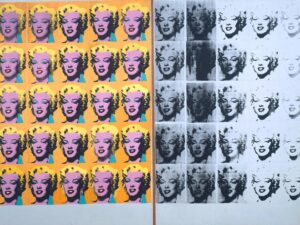Introduction
Frank Stella (b. 1936)
Roy Lichtenstein (1923- 1997)
Richard Anuszkiewicz (1930-2020)
Armand Fernandez (1928-2005)
Billy Apple (1935-2021)
David Weinrib (1924-2016)
Let’s review the relationship of art to Simple Reality. “Much of the rapid change in modern styles results from the attempt to avoid preconceptions about art. Earlier ideas about art, whether of subject matter or form, are thought to interfere with a full appreciation of the work itself. They are seen as distractions.”[i] Actually, there is only one distraction that comes between the viewer and the ability to be fully present and appreciative of beauty and that is the viewer’s identity. Furthermore, the viewer’s identity being determined by P-B is unable to experience the truth of the perfection of the creative process and the resultant “art.”
We have been too narrow throughout history in our definition of art. Each of the categories of art we have examined in this chapter so far art was defined by the worldview of the culture that contained it. Each emerging form of art was a reaction to the old form which was often seen as too restrictive. “From this point of view, the formal conventions of modern art are themselves suspect. They are conceived of as standing between the viewer and the work, and the viewer’s responses are presumably distorted by current notions of good design, form, or color.”[ii] Any conceptions of good design, form, or color are too restrictive in P-A. The truth relating to beauty is that any heart-felt creation is perfect, by definition. Beliefs, attitudes and values shift throughout history as the human story evolves but beauty is timeless when profoundly understood, felt and expressed.
An artist’s canvas has limits and edges just as P-B is restricted by the limitations of its beliefs, attitudes and values which are ultimately illusions. “In paintings such Effingham I [1974], Frank Stella as well as a number of other artists attempted to solve the problem by making the shape of the canvas parallel to the contours of the main form. This eliminated the problem of relating the edges of the main shape to the canvas.”[iii]
Artists, like the rest of us are searching for the truth. Frank Stella unconsciously wanted to eliminate the restrictions or limitations imposed by what he saw as the “reality” of form itself. What he attempted to express in his art was a paradigm shift from P-B to P-A thus eliminating the illusion of the world of form itself and attaining complete freedom of expression.
In their desire to eliminate the illusion of P-B which they felt (albeit unconsciously) as a barrier between them and their audience, they began to choose everyday cultural images that anyone could relate to as subject matter. Hence, their works have become known as “Pop Art.” “Moreover, works such as Roy Lichtenstein’s Drowning Girl [1963] lend themselves easily to social interpretation.”[iv] The implicit social commentary inherent in Pop Art could be interpreted as a criticism of the self-destructive pursuit of plenty, pleasure and power in American culture.
Another group of artists attempting to connect with a larger public put their emphasis on the “optical” effects of color, line and shape and hence came to be known as Op artists. “Paintings such as Richard Anuszkiewicz’s Complementary Fission [1964] rely, in large part, on the theories of color and optical mixture of hues first explored by Impressionists such as Monet and Seurat. Unlike the Impressionists, however, the Op artists have rigidly excluded any reference to nature.”[v]
Modern artists like Arman Fernandez have also incorporated new materials such as plastics and acrylics into their work. “In Precious Iceberg, for example, he squeezed out pigment from paint tubes and then poured around them some polyester tinted to a green hue.”[vi] Observers of Arman’s work have commented that is seems to have multiple layers of meaning or like P-B itself, reality is not what it might “seem” to be initially.
Another area of modern experimentation in art had to do with the use of lighting effects. “Some of the artists working with lights have been concerned with light images in motion, others with bouncing lights off highly reflective surfaces such as vinyl, and still others with intensely glowing effects of neon lights.”[vii] U.F.O. (1967) by Billy Apple provides us with an example of this. David Weinrib combined light suffused through tinted plastics as in his piece entitled Star.
[i] Freier, Robert. Adventures in Modern Literature. New York: Harcourt. 1970, page 425.
[ii] Ibid.
[iii] Ibid.
[iv] Ibid.
[v] Ibid., page 426.
[vi] Ibid.
[vii] Ibid.
Pop and Op Art Table of Contents
_______________________________________________________
Find a much more in-depth discussion in books by Roy Charles Henry.



